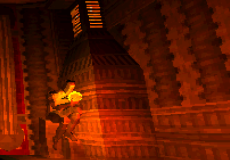

Don’t Scream
Don’t Scream is a first-person horror game built around sound control and player composure. The premise is simple: survive for a set duration without making noise. The microphone becomes the central mechanic, turning every sound or reaction into a measurable input. If the player screams, gasps, or speaks above a certain threshold, the session ends immediately. The game challenges the player to maintain stillness and restraint while navigating a space designed to provoke constant tension.
Similiar games
Don’t Scream is a first-person horror game built around sound control and player composure. The premise is simple: survive for a set duration without making noise. The microphone becomes the central mechanic, turning every sound or reaction into a measurable input. If the player screams, gasps, or speaks above a certain threshold, the session ends immediately. The game challenges the player to maintain stillness and restraint while navigating a space designed to provoke constant tension.
Structure and Core Concept
In Don’t Scream, movement and observation replace combat or puzzles. The player walks through a confined area filled with unpredictable auditory and visual triggers. The environment shifts slightly with each step—lights flicker, doors move, and unseen sounds approach. The game tracks time silently, counting down as long as the player remains quiet. Every scare tests control rather than reflex, creating a cycle of pressure that increases the closer one gets to the end. The rules are minimal, but the implications are clear: silence is survival.
Systems and Core Features
The primary mechanics of Don’t Scream include:
· Microphone-based input that ends the session if the player reacts audibly
· Real-time environmental distortion triggered by player movement
· A timer system requiring full composure for a complete run
· Randomized events that prevent memorization of patterns
· Continuous feedback on noise level for awareness and pacing
These systems create tension through restraint rather than direct threat. The player becomes both participant and observer, managing internal response while navigating external uncertainty. Each playthrough feels slightly different, as sound and lighting shift unpredictably.
Progression and Feedback
Progress in Don’t Scream is measured not by distance or objectives but by endurance. Each session resets upon failure, forcing the player to start again from the beginning. Success requires learning environmental rhythm and anticipating jumpscares without reacting physically. Over time, players adjust breathing, movement, and focus to maintain silence. This repetition transforms gameplay into a controlled psychological exercise. Finishing the timer once feels less like victory over danger and more like mastery of personal reaction.
Design and Experience
Don’t Scream’s design relies on simplicity and consequence. There are no menus, inventories, or scripted dialogues—only the player, the space, and the rule of silence. This minimalism strengthens immersion, as every sound becomes meaningful. The tension arises not from visible danger but from expectation and restraint. The game functions as a study in control, using technology to connect the player’s real-world behavior with in-game consequence. Through this structure, Don’t Scream demonstrates how fear and self-discipline can coexist within a single, sustained moment of focus and quiet endurance.
Discuss Don’t Scream




















